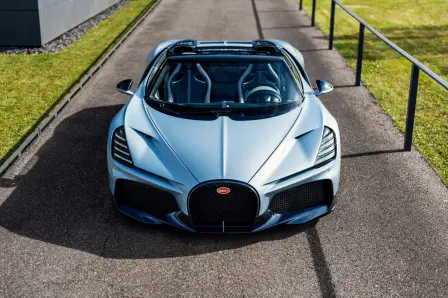
Bugatti W16 Mistral enters final testing phase: expanding a legacy

Molsheim
Bugatti has a storied history when it comes to performance roadsters, with a lineage that spans more than a century of automotive innovation. From the legendary Type 35 to the iconic Veyron Grand Sport Vitesse, the brand has consistently pushed the boundaries of design and performance in the realm of open-top automobiles. The latest page in this tale is the W16 Mistral.








Significant in so many ways, the W16 Mistral¹ represents the first open-top model to leave Molsheim since 2015 and a swansong for the brand’s incomparable W16 engine. Given the importance of the project, as well as Bugatti’s devotion to maintaining the standards synonymous with the marque, the testing program set out for the Mistral was exhaustive – and it must be.
At the heart of the Mistral lies the definitive incarnation of the iconic W16, new meticulously honed aerodynamic attributes and an entirely reengineered monocoque. To fuse these elements to deliver unrelenting performance, acoustic excellence, and ultimate luxury, whilst enabling a top speed in excess of 420km/h, is an extreme balancing act.
Yet, Bugatti – in its commitment to delivering the highest standards of performance, safety, and durability – has undertaken a careful evaluation of every aspect of the Mistral's design. The engineers have left no stone unturned in their quest to create Bugatti’s ultimate roadster. Now, as we enter the second half of 2024, the W16 Mistral is entering its final evaluation phase.
“We are in the last part of the testing program – we are getting close to the finish. From the initial validation stages to the intensive endurance tests, every aspect of the Mistral's development is precisely planned and executed. The Mistral is the ultimate example of our dedication to setting new standards in roadster design.”
Emilio Scervo
CTO of Bugatti RimacStringent crash tests already successfully undertaken have ensured the Mistral's ability to protect occupants in the event of a collision. An essential phase given the integration of a new monocoque in the new design, and a vital part of obtaining homologation for different markets, including North America and Europe, these tests comply with their respective international safety standards.
Now, having also completed aerodynamic evaluation back in October, and the W16 and its transmission having been put through their paces on the dynamometer to ensure that they deliver the exhilarating performance expected, Bugatti is subjecting its Mistral prototypes to a succession of tests to analyse its performance under various driving conditions. These tests look at safety, emissions, endurance, and drivability.
The road tests for the Bugatti Mistral are thorough. Prototype 2 alone has already covered an impressive distance of 32,000km, showcasing its adaptability and durability capabilities. These road tests have taken the W16 Mistral through various terrains, at high altitudes in the mountains, at sea level, and even through heavy traffic conditions. Looking ahead, Bugatti will push the limits even further by adding another 5,000 kilometres on the track. With this rigorous regime, Bugatti will accumulate a total of 40,000km on just this vehicle – a figure not yet reached by most modern-day Bugatti customer cars.
One of the most challenging aspects of the latter testing process is expected to be verification of the Mistral's top speed. However, this is only as engineers encounter the logistical challenge of finding a suitable track that allows the Mistral to reach over 420km/h safely. Despite this, the brand is confident that the Mistral will break records and exceed any expectations.
“We are planning to run the final high-speed test in one of the very few tracks around the world that allow us to run the test in safe conditions. The moment that we have access to that track, however, achieving the top speed will no longer be a problem.” added Emilio Scervo.
Throughout the testing phase of the Mistral’s development, Bugatti has remained dedicated to delivering a car that not only meets the performance standards expected from Bugatti but also sets new benchmarks for safety and reliability in a hyper sports roadster, all while offering an unparalleled luxury and driving experience. With the Mistral nearing the end of its testing journey, production of Bugatti’s most aerodynamic and emotional roadster to date is expected to begin at the Molsheim Atelier later this year.
